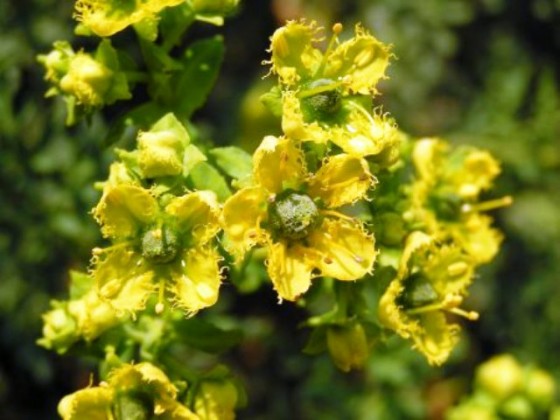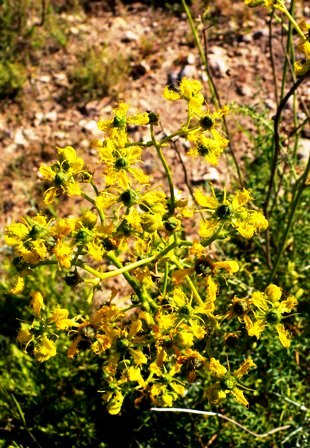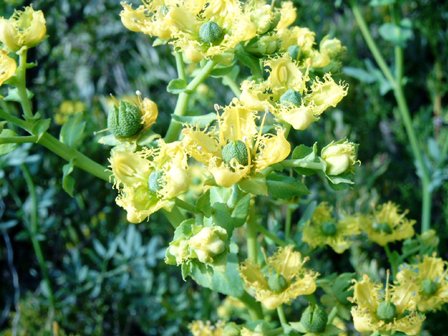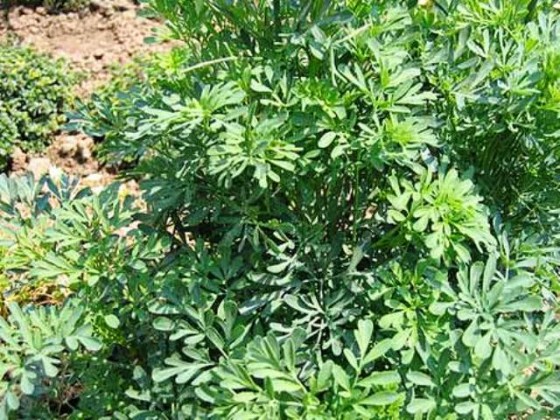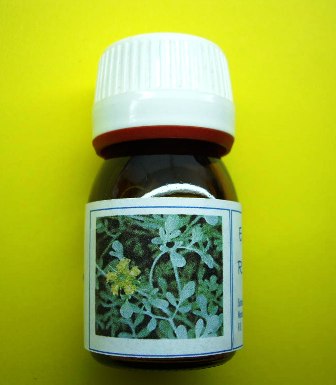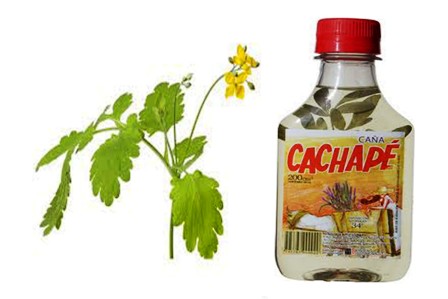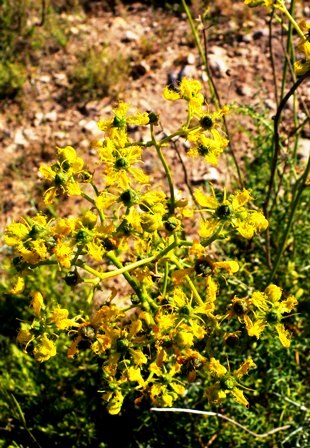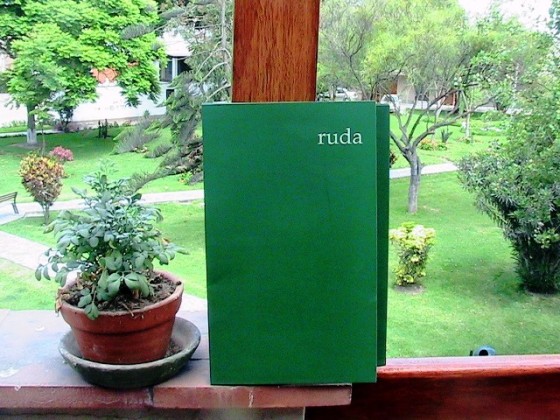http://es.scribd.com/flavia_yanes/d/83077462-NATUROPATIA-GENERAL
AVISO IMPORTANTE
miércoles, 29 de febrero de 2012
martes, 28 de febrero de 2012
Medicina natural y endocrinología
(Extraído de Repositorio de artículos)
Endocrinología
Archivado en: MNT en especialidades — mednat @ 20:06
Enlaces a artículos a texto completo sobre aplicaciones de la Medicina Natural y Tradicional en la actividad de Endocrinología.
Garlic improves insulin sensitivity and associated metabolic syndromes in fructose fed rats. Nutrition & Metabolism 2011, 8:53.
Alternative therapies useful in the management of diabetes: A systematic review. J Pharm Bioallied Sci. 2011 Oct-Dec; 3(4): 504–512.
Effect of yoga therapy on reaction time, biochemical parameters and wellness score of peri and post-menopausal diabetic patients. Int J Yoga. 2012 Jan-Jun; 5(1): 10–15.
Effects of Native Banana Starch Supplementation on Body Weight and Insulin Sensitivity in Obese Type 2 Diabetics. Int J Environ Res Public Health. 2010 May; 7(5): 1953–1962.
Hypoglycemic herbs and their action mechanisms. Chin Med. 2009; 4: 11.
Mindfulness-Based Stress Reduction and Diabetes. Diabetes Spectr. 2009 September 21; 22(4): 226–230.
Natural flavonoids as potential multifunctional agents in prevention of diabetic cataract. Interdiscip Toxicol. 2011 June; 4(2): 69–77.
Preliminary Study of the Clinical Hypoglycemic Effects of Allium cepa (Red Onion) in Type 1 and Type 2 Diabetic Patients. Environ Health Insights. 2010; 4: 71–77.
Traditional Chinese Medicine in Treatment of Metabolic Syndrome. Endocr Metab Immune Disord Drug Targets. 2008 June; 8(2): 99–111.
Fruit and vegetable intake and incidence of type 2 diabetes mellitus: systematic review and meta-analysis. BMJ. 2010; 341: c4229.
Complementary and Alternative Medicine in Children with Type 1 Diabetes Mellitus. J Clin Res Pediatr Endocrinol. 2011 September; 3(3): 139–143.
lunes, 27 de febrero de 2012
Developments on drug discovery and on new therapeutics: highly diluted tinctures act as biological response modifiers.
(Extraído de PubMed.gov)
BMC Complement Altern Med. 2011 Oct 26;11:101.
de Oliveira CC, Abud AP, de Oliveira SM, Guimarães Fde S, de Andrade LF, Di Bernardi RP, Coletto EL, Kuczera D, Da Lozzo EJ, Gonçalves JP, Trindade Eda S, Buchi Dde F.
Source
Laboratório de Estudos de Células Inflamatórias e Neoplásicas, Departamento de Biologia Celular, SCB, Centro Politecnico, Universidade Federal do Paraná - Curitiba, CEP 81531-980, PR - Brazil.
Abstract
BACKGROUND:
In the search for new therapies novel drugs and medications are being discovered, developed and tested in laboratories. Highly diluted substances are intended to enhance immune system responses resulting in reduced frequency of various diseases, and often present no risk of serious side-effects due to its low toxicity. Over the past years our research group has been investigating the action of highly diluted substances and tinctures on cells from the immune system.
METHODS:
We have developed and tested several highly diluted tinctures and here we describe the biological activity of M1, M2, and M8 both in vitro in immune cells from mice and human, and in vivo in mice. Cytotoxicity, cytokines released and NF-κB activation were determined after in vitro treatment. Cell viability, oxidative response, lipid peroxidation, bone marrow and lymph node cells immunophenotyping were accessed after mice in vivo treatment.
RESULTS:
None of the highly diluted tinctures tested were cytotoxic to macrophages or K562. Lipopolysaccharide (LPS)-stimulated macrophages treated with all highly diluted tinctures decreased tumour necrosis factor alpha (TNF-α) release and M1, and M8 decreased IFN-γ production. M1 has decreased NF-κB activity on TNF-α stimulated reporter cell line. In vivo treatment lead to a decrease in reactive oxygen species (ROS), nitric oxide (NO) production was increased by M1, and M8, and lipid peroxidation was induced by M1, and M2. All compounds enhanced the innate immunity, but M1 also augmented acquired immunity and M2 diminished B lymphocytes, responsible to acquired immunity.
CONCLUSIONS:
Based on the results presented here, these highly diluted tinctures were shown to modulate immune responses. Even though further investigation is needed there is an indication that these highly diluted tinctures could be used as therapeutic interventions in disorders where the immune system is compromised.
Texto completo: http://www.ncbi.nlm.nih.gov/pmc/articles/pmid/22029602/?tool=pubmed
Complementary and alternative medical therapies for children with attention-deficit/hyperactivity disorder (ADHD).
(Extraído de PubMed.gov)
Altern Med Rev. 2011 Dec;16(4):323-37.
Pellow J, Solomon EM, Barnard CN.
Source
University of Johannesburg, Department of Homeopathy, Johannesburg, South Africa. jpellow@uj.ac.za
Abstract
Attention-deficit/hyperactivity disorder (ADHD) is a commonly diagnosed childhood disorder characterized by impulsivity, inattention, and hyperactivity. ADHD affects up to 1 in 20 children in the United States. The underlying etiologies of ADHD may be heterogeneous and diverse, and many possible risk factors in the development of ADHD have been identified. Conventional treatment usually consists of behavioral accommodations and medication, with stimulant medication most commonly being prescribed. Parents concerned about the side effects and long-term use of conventional medications are increasingly seeking alternatives to pharmacologic treatment. Complementary and alternative medicine (CAM) offers parents various treatment options for this condition, including dietary modifications, nutritional supplementation, herbal medicine, and homeopathy. CAM appears to be most effective when prescribed holistically and according to each individual's characteristic symptoms. Possible etiologies and risk factors for the condition also need to be considered when developing a treatment plan. This article serves to highlight the latest research regarding the most commonly used CAM for children with ADHD.
Texto completo: http://www.altmedrev.com/publications/16/4/323.pdf
El magnesio reduce el riesgo de sufrir un ACV
(Extraído de lanacion.com.ar)
Una alimentación que asegure un alto aporte de ese micronutriente reduce un 8% las posibilidades de un infarto cerebral
Una alimentación rica en magnesio reduce el riesgo de padecer un ataque cerebrovascular (ACV). Esta conclusión se desprende de un estudio publicado en el American Journal of Clinical Nutrition, basado en un riguroso relevamiento de las bases de datos de diferentes investigaciones realizadas en los últimos 45 años.
El oportuno cruce de la información allí disponible relacionada con la cantidad de magnesio consumida y el porcentaje de casos de ACV verificados a través del tiempo en dichos estudios reveló que la ingesta de magnesio en la dieta está asociada inversamente al riesgo de ataque cerebro vascular, especialmente de ACV isquémico -el más frecuente, provocado por un coágulo que interrumpe el flujo sanguíneo.
Dicho de otro modo, a mayor consumo de alimentos con alto contenido de magnesio, menor es el riesgo de sufrir un ACV.
Investigadores del Instituto Nacional de Medicina Ambiental de Suecia relevaron para su artículo, entre otros, siete estudios publicados en los últimos 14 años, cuyos resultados sugieren una disminución de un 8% del riesgo de sufrir un ACV isquémico por cada 100 miligramos extra de magnesio consumido por día. Dichos estudios contaron con un universo de más de 250.000 participantes de Estados Unidos, Europa y Asia, un 3% de los cuales padeció un ACV durante el lapso promedio de 11,5 años que duraron los seguimientos.
Según el doctor. Pedro Lylyk, director del Centro Integral de ACV de la Clínica La Sagrada Familia, "este hallazgo es consistente con otros estudios epidemiológicos previos que reportaron que bajos niveles de magnesio se podían asociar con el aumento del riesgo de ACV". Teniendo en cuenta que la hipertensión es la causa principal del ataque cerebral, la asociación entre el consumo de magnesio y la posibilidad de padecer un ACV se debería, en parte, "al efecto del magnesio sobre la hipertensión, ya que el magnesio es un antagonista natural del calcio y modula el tono vascular, la presión sanguínea y el flujo de sangre periférico", explicó Lylyk.
El magnesio parece aumentar a su vez el efecto antihipertensivo de los medicamentos para bajar la presión arterial, así como mejorar los tratamientos para el síndrome metabólico, la diabetes, dislipidemia, todos factores que aumentan el riesgo de ACV, según informó el doctor Carlos Ingino, cardiólogo del Instituto Médico ENERI.
Los resultados no serían, sin embargo, definitivos. Como advierte la doctora Susana Larsson, integrante del equipo de investigación sueco, aún es necesario realizar estudios de mayor profundidad. Esto se debe a que el análisis se concentró en el mineral presente en los alimentos, por lo que no puede descartarse la posibilidad de que los resultados se hayan visto influidos en cierta medida por algún otro aspecto de los alimentos ingeridos. "Es importante notar que el estudio se refiere a una dieta rica en magnesio, y no a alimentos en particular o a suplementos", agregó la licenciada Andrea Rochaix, nutricionista.
El magnesio es un mineral indispensable para el funcionamiento de nuestro organismo. Entre otras muchas funciones, que se suman a las ya referidas, cumple un rol destacado en la contracción y relajación muscular, en la producción y transporte de energía, como así también en el funcionamiento de ciertas enzimas y en la producción de proteínas. También es esencial para la asimilación del calcio y de la vitamina C.
Se estima que la cantidad de magnesio que una persona posee en el cuerpo es de alrededor de 25 gramos, algo más de la mitad de ellos en el esqueleto y un 27% en los músculos.
Algunas circunstancias pueden, sin embargo, reducir estos niveles normales de magnesio en el organismo, entre ellas padecer ciertas enfermedades estomacales e intestinales, diabetes, un déficit en la función renal, así como mantener un consumo excesivo de café, refrescos, sal o alcohol. Los periodos menstruales abundantes, el estrés prolongado y el uso de diuréticos pueden también desencadenar deficiencias.
Una ingesta adecuada de magnesio es por ello necesaria. Como explica la Lic. Rochaix, los alimentos que lo aportan en mayor cantidad son los vegetales, sobre todo las verduras de hoja verde oscura, así como las frutas secas, el salvado de trigo, las legumbres, los lácteos, las carnes y el chocolate. Las dosis diarias recomendadas de magnesio, a ingerir a través de una dieta balanceada, son:
En niños:
. de 1 a 3 años: 80 miligramos
. de 4 a 8 años: 130 miligramos
. de 9 a 13 años: 240 miligramos
. de 14 a 18 años: 410 miligramos en varones y 360 miligramos en mujeres.
En adultos:
. En mujeres: de 310 a 320 miligramos (de 350 a 400 mg durante el embarazo)
. En hombres: de 400 a 420 miligramos.
La siguiente tabla contiene algunos de los alimentos con mayor aporte de magnesio, expresado su contenido en miligramos por cada 100 gramos de porción comestible:
Alimentos y su contenido en magnesio
Almendras, cacahuetes 250
Garbanzos, guisantes 150
Avellanas, pistachos, nueces 150
Maíz 120
Chocolate 100
Pan integral 91
Lentejas 78
Cigalas, langostinos, gambas 76
Acelgas 76.
Homeopathic St. John's Wort: Good for More Than Just Depression
(extraído de huffingtonpost.com)
by Larry Malerba, D.O.
In this age of antidepressant overprescribing, popular herbal preparations of St. John's Wort have become an excellent first line of defense in mild depression for those concerned about pharmaceutical side effects. But did you know that a diluted homeopathic form of St. John's Wort is highly useful for a wide variety of additional health-related problems? Homeopathic Hypericum perforatum, named for the Latin genus and species of the plant, is effective for many conditions that involve nerve injuries and puncture wounds.
I remember my first experience with Hypericum in medical school. A woman with chronic arm pain resulting from a severe injury to her "funny bone" (a large nerve exposed at the elbow called the ulnar nerve) consulted the physician with whom I was doing a preceptorship. Previously an accomplished guitar player, she had endured years of pain and, in spite of surgery to the nerve, was no longer able to perform. The doctor prescribed several doses of homeopathic Hypericum and, within a few weeks, she experienced a 50 percent reduction in pain. This simple case example illustrates the most common indication for Hypericum -- injuries to nerves.
There are a number of areas of the body that are rich in nerves, most notably the fingertips, tailbone, and eyes. Because of the high density of nerve endings in these areas, they can become very painful when injured. We all know how painful an injury as minor as a paper cut can be. The good news is that cuts, bruises, and crush injuries to the fingertips will respond quite nicely to homeopathic Hypericum. Just a few doses can help reduce pain and speed the healing process.
A common feature of nerve injuries is that pain often radiates along the nerve starting from the site of the injury. An example of this type of nerve injury occurs when a person falls and lands on his or her tailbone. The tip of the spine, or coccyx, is essentially where the spinal cord ends, and injuries to this area can be very painful. I was once consulted by a young man who had severely injured his tailbone. He reported years of suffering, primarily in the form of nerve pains that radiated from his coccyx down both legs. His condition had turned something as basic as walking into a painful experience. Periodic doses of Hypericum over the course of several months rendered him virtually pain free.
Likewise, a direct injury to the eyeball that results in sharp, sticking, nerve-like pains may respond well to Hypericum. In such cases, it is very reasonable to take a few doses of Hypericum in quick succession followed by a prompt medical evaluation in order to rule out potential complications and ensure a safe recovery.
The other main indication for Hypericum is for the effects of puncture wounds. Whether the injury is from a needle, a nail, a splinter, a shard of glass, or an insect stinger, the administration of a few doses of Hypericum in the initial phase of such injuries is a good precaution to take in order to prevent pain, inflammation, and further complications. Again, depending on the type and extent of injury, a physician should be consulted if infection is suspected or if problems persist.
I once saw a woman who complained of chronic nerve pain radiating down her leg. She was certain that the pain had begun after she was given an epidural injection to manage pain during labor and delivery. Here, we see an interesting conjunction of Hypericum indications, a puncture wound via injection administered to a nerve center of the body, the spinal cord. Thankfully, periodic doses of Hypericum resulted in the complete disappearance of her pain within a couple of months.
The very same conjunction of circumstances occurs during routine dentistry. Lidocaine injections are used to block nerves innervating the roots of teeth. This modern anesthetic miracle can prevent dentistry from being a harrowing experience, but the aftermath can be painful. It is not that uncommon that this type of dental anesthesia can lead to chronic symptoms like facial numbness, tingling, and pain associated with the location of the injection. This is why I recommend a couple of routine doses of Hypericum to my patients to be taken immediately after completion of dental visits in order to prevent such complications. For the same reasons, I also recommend it after tooth extractions and root canals.
It should be noted that homeopathic Hypericum perforatum is not the same as herbal St. John's Wort and neither is it a nutritional supplement. Herbal and homeopathic forms of St. John's Wort have different indications and different guidelines for their usage. Another difference is that homeopathic Hypericum comes in very diluted form and is FDA approved and regulated. This article offers only a brief introduction to some of the uses of this wonderful medicine. It's reputation for safety and effectiveness is well known. Hypericum is sold over the counter at most natural health stores and is easy to use with a little self-education regarding homeopathic medicines and how to use them for first-aid purposes.
More on Hypericum perforatum:
Herbal use: St. John's Wort & Depression Homeopathic use: Hypericum perforatum - Homeopathic First Aid Remedy, by Deborah Olenev C.C.H., RSHom (NA) Reference: Frans Vermeulen, Concordant Materia Medica, Emryss Publishers, Haarlem, The Netherlands, 2000, pp. 794-98
miércoles, 22 de febrero de 2012
lunes, 20 de febrero de 2012
Ruda hembra y ruda macho
(Extraído de viajes.elpais.com.uy)
Ruda hembra y ruda macho
Ni hembra, ni macho, ni gay. Compilé todo lo científico, mágico y brújico. Esta es la planta de los más rudos misterios.
La gente asegura que hay ruda hembra (más chiquita y más florida) y ruda macho (más grande y masculina), pero resulta que la planta es hermafrodita y se las arregla sola; un onanismo de alto vuelo. Así que la planta tiene órganos masculinos y femeninos al mismo tiempo; no la vayas a confundir con una planta gay, porque andá a saber si no lo toma a mal y no querrías enemistarte con una ruda. Estaremos equivocados con su sexualidad, pero mirá que nadie anda en internet desmintiendo sus propiedades mágicas.
Solo por tener argumentos racionales, no intentes derribar tradiciones; vos conseguite una “ruda hembra” y plantale al lado una “ruda macho”; no conseguirás que se apareen, pero evitarás la envidia y lograrás que el gato del vecino no vuelva a orinarte el patio… eso es lo que dicen y no te atrevas a desmentirlo, mirá que en estas cosas la evidencia está sobrando. Además, tanta actitud científica da un poco de asco.
Ruta angustifolia (izq) y Ruta chalepensis (der), abajo la que conocemos como ruda macho. La más popular en Uruguay es la Angustifolia, la ruda hembra. Pero parece que no tiene tantos atributos si no se le pone de compañera a la ruda macho de hoja grande y mayor tamaño.
La leyenda fue favorecida porque las dos variedades comunes en nuestra región están claramente diferenciadas, tal como si fueran variables sexuales. Los paisanos de Uruguay, Argentina, Chile y Paraguay, le llaman Ruda Hembra a la “Ruta Graveolens” que tiene una altura no superior a 50 centímetros y hojas más pequeñas. Es la la “Ruta Chalepensis” que la denominan Ruda Macho, que llega a tener un metro de alto y hojas notoriamente más grande. La cosa se complica un poco porque no son las únicas variedades de una planta que, por otra parte, no es ni remotamente oriunda de estas tierras.
Personalmente tengo una larguísima historia personal con la ruda, pues siendo niño pequeño, durante una de las recaídas que finalmente terminaron con la vida de mi padre, estuve al cuidado de unas tías que eran devotas de todo, incluyendo la ruda. Me ponían un ramito de ruda bajo la almohada y siempre me contaban que esperaba que se fueran y apenas quedaba solo, me desprendía del fuertísimo gedor, por más que me aseguraran que alejaba tanto a los microbios, como a la envidia y a la mala onda. Tuve que soportar cataplasmas y hasta semillas de ruda cosidas dentro del forro de un saco.
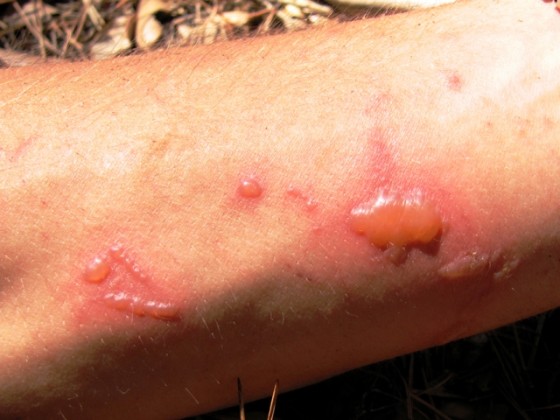
Desde chiquito preferí ponerle el pecho a las contrariedades… claro que así me fue, todo por no confiar en la ruda. Lo que ocurrió es que el aroma de la ruda me resultó insoportable por muchísimos años. Pero no es lo que ocurre habitualmente con la gente.
Vos pensá lo que quieras, pero hay mucha gente que le tiene muchísima fe a la ruda, a la ruda hembra, a la macho y a la que sea. Su principal uso es el de alejar la envidia, razón seguramente por la cual es tan popular en Uruguay. Pero también sirve para conservar a la pareja, para tener dinero, buena suerte, espantar a las mujeres o a los hombres (¡mirávo!) y para casi todo lo que se e ocurra, hasta para causarte una brutal irritación cuando te la frotás en la piel y luego actúa el sol.
Para empezar, visitá http://www.chileflora.com/Florachilena/FloraSpanish/HighResPages/SH0650.htm , mirá fotos de ruda macho (Ruta Chalepensis) en http://www.chileflora.com/Florachile…ges/SH0650.htm y luego comparalas con las de ruda hembra (Ruta Graveolens) en http://es.wikipedia.org/wiki/Archivo…raveolens3.jpg.
De lo contrario quedate aquí, donde compartiré lo que encontré y transcribiré textualmente lo que refiere a sus propiedades mágicas (al final). Eso sí, no me preguntes porqué “ruda” se convirtió en “ruta” porque no lo explican en ninguno de los sitios que visité.
Para empezar, las entre 40 especies son nativas del mediterráneo y/o del sudoeste de Asia, pero la ruda estrella de todo el planeta es la Ruta graveolens, esa misma que tenés cerca de la puerta de tu casa o de la casa del vecino y no me vengas con “yo no creo en esas cosas”. Si compraste la planta o lograste reproducir una, hiciste algo nada aconsejable, a la ruda hay que robarla para que tenga más poderes.
Ya se la mencionaba en la Biblia y los romanos la incorporaban en muchas recetas, de cuando la gastronomía apetecía sabores rudos, valga la redundancia. Su sabor es todavía apetecido en algunas zonas del norte de África, pese a que como comestible tiene el riesgo de que te pasás de la dosis y ¡zás! te tienen que internar. Y eso vale para todos los yuyos y la medicina folklórica, no es chiste que contienen principios activos que tanto te pueden curar como te pueden matar. No se te ocurra tomar al pie de la letra todo lo que te asegura la tía vieja o te encontrás en internet.
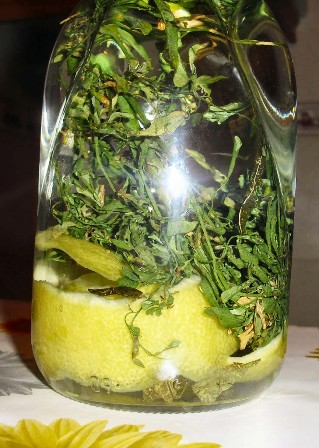
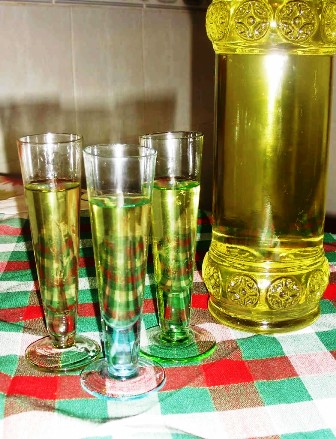
Los italianos que suelen hacer Grappa casera (que Dios los tenga en la gloria) suelen agregar alguna flor a la botella y hasta poner un poco en las salsas. En Etiopía, que es donde inventaron el café, se lo agregan solo en una mezcla denominada berbere para saborizarlo. Y en algunas regiones de Italia encuentran exquisita una salsa de tomate que contiene ruda, además de aceitunas, alcaparras, mejorana y albahaca.
El color azul verdoso de la ruda hembra es realmente atractivo y aunque la planta es un poco despatarrada, si le das forma puede ser un buen ornamento ubicada a razonable distancia de tu ruda macho con el cual conforma el casal recomendado por la tradición y desmentido por la ciencia. Además, no siempre la ciencia se ajusta al amor, que como bien sabemos no tiene límites ni conoce diferencias.
Las flores son amarillas y tienen entre 4 y 5 pétalos de un centímetro de ancho. El fruto es lobulado y contiene una cápsula con numerosas semillas. Basta que aprietes cualquier parte de la planta, para que despida aquél olor fuerte que tanto odié de niño y tanta nostalgia me despierta hoy en día. ¿Te fijaste que no la fajina ninguna hormiga y que los caracoles la esquivan cuidadosamente? Era esperable en una planta que domina la magia, los depredadores, entre los cuales estás vos, no saben con quién se meten cuando dañan a una ruda, la misma de los ramilletes que distribuía la loca Ofelia según el Hamlet de William Shakespeare.
También es una planta melancólica que en las canciones folklóricas inglesas se la asocia con la pena. En las mismas canciones se menciona al tomillo, asociado a la virginidad. En Lituania es la flor nacional y simboliza la virginidad y la femineidad. Y acá tenemos uno de los primeros líos asociados con la ruda. Se dice que si ponés ruda junto a la puerta, evitás que ingresen mujeres fastidiosas a tu casa y si ponés tomillo, es a los hombres con mala onda lo que alejás de tu hogar. ¿Vos creías que era cuestión de agarrar una maceta y plantar cualquier cosa?
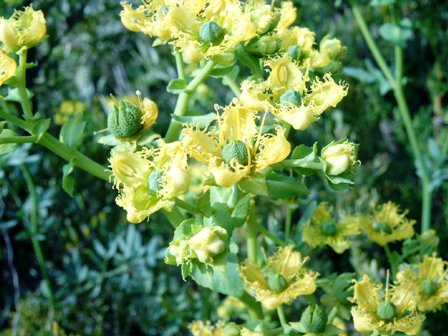
Dice la Wikipedia que la ruda fresca contiene aceites volátiles que pueden dañar al riñón o al hígado. La planta es mejor conocida por sus efectos en el tracto reproductor femenino. Se asegura que puede estimular los músculos del útero, promover un adelanto del período menstrual, funcionar como contraceptivo y hasta desencadenar un aborto. Asegura la misma fuente confiable, que en animales de laboratorio machos, disminuyó la motilidad y el número de esperma, al tiempo que redujo el deseo sexual. Aunque sirve para repeler insectos, cuando se aplica la ruda en la piel se puede producir un efecto fotoirritante en algunos casos. Contiene varios aceites esenciales y alcaloides que pueden causar extrema sensibilidad a los rayos ultravioletas, con la aparición de ampollas y lesiones en la piel.
Nada de esto es chiste ni leyenda, se tiene registro de decesos debidos a hemorragias producidas por dosis repetidas de ruda usada como contraceptivo o abortivo. Así que su administración oral está fuertemente desaconsejada en dosis masivas. Lo que no impide que sea usada y hasta recomendada como infusión.
Dice la Wikipedia que ocasionalmente, “el aceite de ruda se aplica a la piel para mejorar dolor de artritis, y para tratar heridas de tejidos. Los químicos de la ruda pueden interrumpir la liberación corporal de óxido nítrico y de ciclooxigenasa II (involucrados en producir inflamación), por lo que tienen limitada utilidad. La prescripción de drogas antiinflamatorias es más efectiva y segura (http://www.drugdigest.org/DD/DVH/HerbsWho/0,3923,552392%7CRuda,00.html)”
También la Wikipedia asegura que la ruda, cualquiera de ellas, tiene un gran contenido de vitamina C y por esta razón se considera antiescorbútica, aunque no tanto como el limón. Tiene propiedades emenagogas y aseguran que es útil en amenorreas, espasmos gastrointestinales, parasitosis, várices, hemorroides, el vitíligo, dolor de oídos y dolores estomacales. Recomienda usar las hojas frescas y bajo ningún pretexto administrarlo a embarazadas.
RUDOS ENCANTAMIENTOS
Capaz que a esta altura del artículo estás pensando seriamente en sacar la ruda de tu jardín, de tu terraza y hasta de tu balcón. Pues entonces, no lo hagas hasta leerte detenidamente esto y casi recibirte de mago o encantador. Lo encontramos en http://oraculoweb.galeon.com/magiarud.htm donde hay mucho material interesante para quienes tengan estas milenarias inclinaciones.
“Magos, sibilas, curanderos e incluso los modernos homeópatas saben que la ruda es una de las plantas más poderosas que existen tanto en la hechicería como en medicina natural. En Grecia, Hipócrates la recomendaba para aliviar dolores y combatir epidemias, mientras que las curanderas modernas creen que la ruda cura el mal de ojo y atrae el amor, entre otros beneficios.
“Innumerables civilizaciones han sido adoradoras de la ruda. Los romanos, por ejemplo, eran fieles cultores de esta hierba. Era común que los jueces llevaran consigo algunas hojitas cuando debían estar en contacto con algún prisionero, pues existía la creencia de que la ruda los preservaba de las contaminaciones y del mal de ojo.
“Los chinos también le adjudicaron características benéficas. La usaban para contrarrestar las fiebres palúdicas y los malos pensamientos. Para los magos celtas la ruda era una verdadera defensa contra hechizos y trabajos maléficos. Solían usarla para las bendiciones y la sanación de los enfermos. Y ese mismo carácter sagrado tuvo para los egipcios, hebreos y caldeos, quienes afirmaban que la planta de ruda era un don de los dioses.
“En América, los indígenas agregaban esta hierba en sus gualichos de amor (trabajos o hechizos de amor). Aseguraban, además, a las enamoradas, que con apenas exponer unas pocas ramas a la luz de la Luna y después entregárselas a sus amados, conseguirían conquistar el corazón del ser querido.
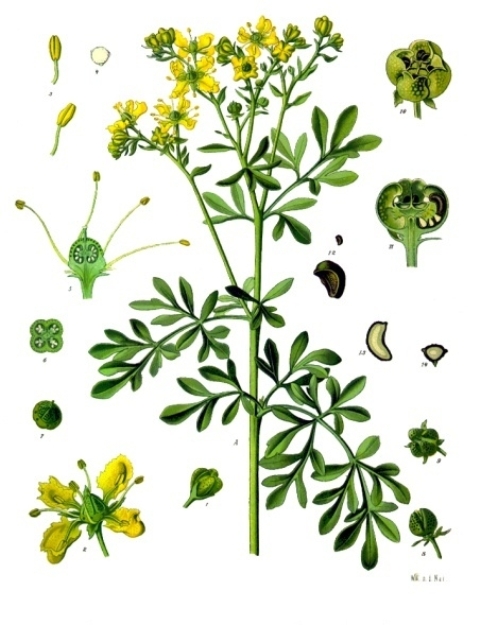
PROPIEDADES DE LA RUDA
PROTECCIÓN: Esta es tal vez la más conocida de sus virtudes. Protege de manera general. Preserva de accidentes, ataques psíquicos de espíritus inferiores, de la envidia, etc. Actúa como prevención, pues crea un campo protector alrededor de quien la posea.
ATRACCIÓN POSITIVA: Permite atraer a las personas correctas, ya se trate de amigos o de parejas, siempre que se la utilice correctamente.
CURACIÓN: La ruda beneficia el cuerpo físico. Por eso, si alguien es propenso a padecer enfermedades, será recomendante acudir a las dotes sobrenaturales que ofrece esta hierba.
EXORCISMO: La ruda contiene propiedades que atenúan la negatividad y permiten expulsar a las entidades del bajo astral. Aleja y, a la vez, absorbe con gran facilidad las corrientes energéticas que puedan perturbar la paz del hogar.
PLANTE SU PROPIA RUDA DE PODER
“Si bien se suele afirmar que la ruda más poderosa es aquella que se toma de un jardín ajeno, la que nosotros mismos plantamos también posee poderes fantásticos. Ya sea a partir de una semilla o de un gajo, lo importante es que usted y no otra persona sea quien la siembre, ya que sus manos serán las transmisoras de su energía y de su magnetismo personal, ingredientes básicos para que su planta crezca e irradie buenos fluidos.
“Antes de comenzar su labor procure tener en cuenta lo siguiente:
• Jamás plante ruda en un estado depresivo o en momentos en que no se siente bien (tampoco si es mujer y esta menstruando). Si lo hace con ira o por curiosidad, para verificar luego que sucede, los resultados probablemente no van a ser los esperados.
• Dedíquele los cuidados necesarios pero no exagere. No esté constantemente pendiente de ella. Colóquela, de ser posible, en un jardín donde reciba mucho sol. Algunos ocultistas recomiendan ubicarla siempre del costado izquierdo del jardín o de la maceta si es ruda macho. Si es hembra, en el derecho. (La ruda es hembra cuando sus hojas son pequeñas y es macho cuando sus hojas son grandes).
• En el caso de poseer felinos, trate de situarla en una zona donde ellos no se aproximen, pues la ruda espanta a ciertos animales, como los gatos y los sapos.
• No se preocupe al notar que su plantita comienza a marchitarse. Es más, no haga ningún intento por salvarla. Esta es una clara señal de ella ha comenzado a obrar para su bienestar, absorbiendo la negatividad que se encuentra en el ambiente. Cuando esto ocurra, compre otra y repita la operación anterior.
COMO HACER UN ENCANTAMIENTO
“Para aumentar la eficacia de las hierbas, se puede recurrir a un proceso simple de encantamiento que tenga como objetivo equilibrar las vibraciones de la planta hasta llevarla a la misma frecuencia de nuestra necesidad mágica. Esta práctica deberá hacerse momentos antes de comenzar cualquier hechizo.
Encante correctamente sus hierbas siguiendo estos pasos:
• Tome las hierbas (hojas, tallos, ramas) que indique el ritual y viértalas en un cuenco de madera.
• A cada lado del recipiente encienda una vela. A su derecha, una blanca para la protección y la espiritualidad. A la izquierda, una amarilla para incrementar los poderes psíquicos y mentales. Hágalo en un lugar donde se encuentre a solas.
• Recoja la ruda con sus manos y trate de visualizar con fuerza aquello que anhela alcanzar, por unos momentos. Concéntrese en el contacto entre las yemas de sus dedos y el vegetal.
• Para culminar con el encantamiento, eleve el cuenco hacia el cielo y haga la siguiente afirmación: “Ruda, bendita ruda, te encanto para que te conviertas en mi poderosa aliada”. Una vez finalizado este último paso, prosiga con el ritual elegido.
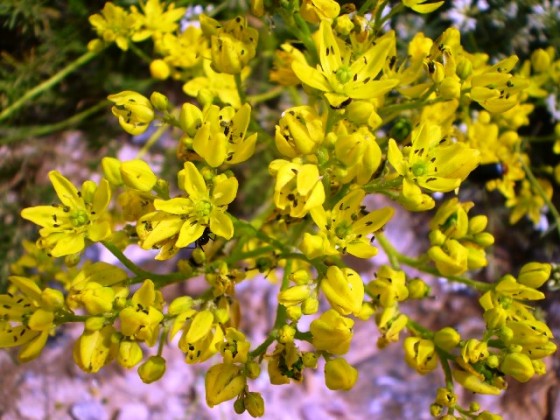
CONTRARRESTRE LAS MALDICIONES: Adquiera una pequeña botella de vidrio transparente e introduzca en ella tres alfileres, tres pedacitos de raíces de ruda macho, un puñado de sal gruesa y las cáscara de medió limón. Coloquele la botella en una ventana y déjela allí, sin cambiarla de lugar, y las maldiciones jamás le harán daño.
TENGA SUERTE EN EL AMOR: Prepare este ungüento mágico con un poco de grasa vegetal, aceite de ruda y unas pocas gotas de su perfume personal. Hierva todos los ingredientes juntos y déjelos enfriar. Luego, consérvelos en un frasco cerrado. Use cada noche parte de este ungüento en la zona del corazón y en el pulso o muñeca.
VEA EL FUTURO EN LOS SUEÑOS: Años atrás, las brujas medievales usaban la ruda para descubrir el porvenir y anticipar los sucesos que deparaba el futuro. Si usted desea aplicarla para el mismo fin, decídase a confeccionar su propia almohada y rellenarla con semillas de ruda y una hojita de menta.
PROTÉJASE DE LAS MALAS INTENCIONES: Eche en diez litros de agua siete brotes de ruda y un chorrito de aceite de oliva. Deje reposar por una noche al sereno. Al día siguiente, lave los pisos, las paredes y las puertas de su hogar.
GANE MÁS DINERO: Este hechizo es ideal para que no falte dinero en todo el año. Necesitará para ello, retirar de los extremos de los tallitos de ruda, todos los gajos posibles y envolverlos en plástico. Luego, guárdelos en una bolsita de tela marrón y llévelos en su cartera o billetera.
ALEJE LAS MALAS ONDAS: Junte hojas de ruda secas, redúzcalas a polvo y mézclelas con un poco de azufre (en polvo) y de mirra. Defúmelos donde crea que existen ondas negativas. Cuando acabe de defumar los ambientes, haga una infusión con tres hojitas de ruda macho y vaporice sus prendas de vestir.
PARA AMANSAR A SUS SEMEJANTES: Si usted pretende apaciguar el carácter de algún amigo, familiar o el de cualquier otra persona, sencillamente obtenga de la ruda dos de sus hojas y péguelas en forma de cruz detrás de una foto de la persona difícil. Entierre el retrato cerca de la casa de quien ha sido hechizado y no la saque de allí hasta que no haya surtido efecto.
ACELERE LAS CURACIONES: Construya un muñeco de tela verde y rellene la figura con hojas y brotes de ruda. Una vez terminado, consérvelo con usted por una semana en la cual tendrá que visualizar, con fe, su cura. Finalmente, arroje la ruda al fuego.
COMBATA LA ENVIDIA EN EL TRABAJO: Sobre un retazo de tela de color púrpura, eche diez gotas de zumo de ruda y adhiérala a su escritorio o a su pared más cercana. Coloque, también, pedacitos de la raíz en todas las esquinas para “limpiar” su ambiente laboral. El retazo deberá ser renovado una vez por mes para que no pierda sus poderes.
TERMINE CON LOS DOLORES DE CABEZA: Deje algunas hojas sobre su frente durante unos minutos, enseguida mastique una de las hojas y rápidamente se aliviarán las jaquecas.
CONTRA LOS CÓLICOS: Prepare una simple infusión con ruda y agua bendita y disipará los cólicos de todo tipo.
PIERNAS SANAS: Las viejas curanderas aconsejaban dejar un vaso con agua fresca, una ramita de ruda por dos noches y beberla por la mañana, para aliviar los dolores crónicos en las piernas.
LA INFUSIÓN DE LA FELICIDAD: Hierva un poco de agua junto con una cucharada de miel, una ramita de canela y el tallo de una ruda macho y una ruda hembra. Cuando esté tibia y colada, invite a su pareja con una parte de esta infusión. El resto deberá beberlo usted, mientras repite mentalmente esta oración: “Hierba mágica, hierba sagrada, concédeme ahora, la fidelidad de la persona amada”. Por último, tome los tallos que usó para la infusión y entiérrelos al pie de una higuera.
AMULETO PROTECTOR: Obtenga suficiente cantidad de polvo de ruda, échelo junto con dos granos de pimienta y una moneda de cobre en un saquito de piel. Llévelo siempre con usted para tener una permanente protección contra los peligros callejeros. Si prefiere, en cambio, preservar su casa de robos, déjelo colgado de la puerta principal.
PERFUME AFRODISÍACO: Para despertar el deseo disponga de los siguientes materiales: un ramo de ruda hembra, el jugo de media naranja, una pizca de canela, un clavo de olor, una rosa y cuatro vasos de agua. Hierva todos los ingredientes durante diez minutos. Espere a que se enfríe, cuélelo y repita estas palabras: “Por la sabiduría de San Antonio y las bendiciones de esta ruda se acercarán hacia mí la pasión y la felicidad”. A continuación, su perfume habitual y úselo antes de cada cita.
PARA HACER REALIDAD SUS DESEOS: Escriba en un papel sus deseos más significativos. Aparte, corte la raíz de la ruda en varias partes y embébalas por un día en agua bendita. Después, envuélvalas junto con el papel en un pañuelo blanco, haciéndole nueve nudos para unir sus extremos. Póngalo debajo de su cama y sus sueños se cumplirán.
POR UN MATRIMONIO FELIZ: Esta fórmula consiste en llevar el día de la boda una hojita de ruda en cada zapato y salpicar con infusión de la misma planta la ropa interior de los novios.
http://es.wikipedia.org/wiki/Ruta_graveolens
miércoles, 15 de febrero de 2012
Wound repair and anti-inflammatory potential of essential oils from cones of Pinaceae: preclinical experimental research in animal models.
(Extraído de PubMed.gov)
J Ethnopharmacol. 2011 Oct 11;137(3):1215-20. Epub 2011 Jul 26.
Tumen I, Akkol EK, Süntar I, Keleş H.
Source
Faculty of Forestry, Department of Forest Products Chemistry, Bartin University, 74100 Bartin, Turkey.
Abstract
ETHNOPHARMACOLOGICAL RELEVANCE:
Ethnobotanical surveys revealed that Abies bornmulleriana, Abies cilicica, Abies nordmanniana and Cedrus libani have been used to promote wound healing in Turkish folk medicine. Four different fir species (Abies cilicica subsp. cilicica, Abies nordmanniana subsp. bornmulleriana, Abies nordmanniana subsp. equi-trojani, and Abies nordmanniana subsp. nordmanniana), Cedrus libani and Picea orientalis were assessed for their in vivo wound healing and anti-inflammatory activities.
MATERIALS AND METHODS:
The essential oils from six different coniferous cones were used. In vivo wound healing activity of the plants was evaluated by linear incision and circular excision experimental wound models subsequently histopathological analysis. The healing potential was comparatively assessed with a reference ointment Madecassol(®), which contains 1% extract of Centella asiatica. Additionally acetic acid-induced capillary permeability test was used for the oils' anti-inflammatory activity.
RESULTS:
The essential oils from Cedrus libani and Abies cilicica subsp. cilicica demonstrated the highest activities on the both wound models. Moreover, the oil from Abies nordmanniana subsp. bornmulleriana was found generally highly effective. On the other hand, the rest of the species did not show any remarkable wound healing effect. Results of the present study support the continued and expanded utilization of these plant species employed in Turkish folk medicine.
CONCLUSION:
The experimental study revealed that Cedrus libani and Abies cilicica subsp. cilicica display remarkable wound healing and anti-inflammatory activities.
Copyright © 2011 Elsevier Ireland Ltd. All rights reserved.
The Swiss Government's Remarkable Report on Homeopathic Medicine
(Extraído de huffingtonpost.com)
By Dana Ullman
The Swiss government has a long and widely-respected history of neutrality, and therefore, reports from this government on controversial subjects need to be taken more seriously than other reports from countries that are more strongly influenced by present economic and political constituencies. When one considers that two of the top five largest drug companies in the world have their headquarters in Switzerland, one might assume that this country would have a heavy interest in and bias toward conventional medicine, but such assumptions would be wrong.
In late 2011, the Swiss government's report on homeopathic medicine represents the most comprehensive evaluation of homeopathic medicine ever written by a government and was just published in book form in English (Bornhoft and Matthiessen, 2011). This breakthrough report affirmed that homeopathic treatment is both effective and cost-effective and that homeopathic treatment should be reimbursed by Switzerland's national health insurance program.
The Swiss government's inquiry into homeopathy and complementary and alternative (CAM) treatments resulted from the high demand and widespread use of alternatives to conventional medicine in Switzerland, not only from consumers but from physicians as well. Approximately half of the Swiss population have used CAM treatments and value them. Further, about half of Swiss physicians consider CAM treatments to be effective. Perhaps most significantly, 85 percent of the Swiss population wants CAM therapies to be a part of their country's health insurance program.
It is therefore not surprising that more than 50 percent of the Swiss population surveyed prefer a hospital that provides CAM treatments rather to one that is limited to conventional medical care.
Beginning in 1998, the government of Switzerland decided to broaden its national health insurance to include certain complementary and alternative medicines, including homeopathic medicine, traditional Chinese medicine, herbal medicine, anthroposophic medicine, and neural therapy. This reimbursement was provisional while the Swiss government commissioned an extensive study on these treatments to determine if they were effective and cost-effective. The provisional reimbursement for these alternative treatments ended in 2005, but as a result of this new study, the Swiss government's health insurance program once again began to reimburse for homeopathy and select alternative treatments. In fact, as a result of a national referendum in which more than two-thirds of voters supported the inclusion of homeopathic and select alternative medicines in Switzerland's national health care insurance program, the field of complementary and alternative medicine has become a part of this government's constitution (Dacey, 2009; Rist, Schwabl, 2009).
The Swiss Government's "Health Technology Assessment"
The Swiss government's "Health Technology Assessment" on homeopathic medicine is much more comprehensive than any previous governmental report written on this subject to date. Not only did this report carefully and comprehensively review the body of evidence from randomized double-blind and placebo controlled clinical trials testing homeopathic medicines, they also evaluated the "real world effectiveness" as well as safety and cost-effectiveness. The report also conducted a highly-comprehensive review of the wide body of preclinical research (fundamental physio-chemical research, botanical studies, animal studies, and in vitro studies with human cells).
And still further, this report evaluated systematic reviews and meta-analyses, outcome studies, and epidemiological research. This wide review carefully evaluated the studies conducted, both in terms of quality of design and execution (called "internal validity") and how appropriate each was for the way that homeopathy is commonly practiced (called "external validity"). The subject of external validity is of special importance because some scientists and physicians conduct research on homeopathy with little or no understanding of this type of medicine (some studies tested a homeopathic medicine that is rarely used for the condition tested, while others utilized medicines not commonly indicated for specific patients). When such studies inevitably showed that the homeopathic medicine did not "work," the real and accurate assessment must be that the studies were set up to disprove homeopathy... or simply, the study was an exploratory trial that sought to evaluate the results of a new treatment (exploratory trials of this nature are not meant to prove or disprove the system of homeopathy but only to evaluate that specific treatment for a person with a specific condition).
After assessing pre-clinical basic research and the high quality clinical studies, the Swiss report affirmed that homeopathic high-potencies seem to induce regulatory effects (e.g., balancing or normalizing effects) and specific changes in cells or living organisms. The report also reported that 20 of the 22 systematic reviews of clinical research testing homeopathic medicines detected at least a trend in favor of homeopathy.* (Bornhöft, Wolf, von Ammon, et al, 2006)
The Swiss report found a particularly strong body of evidence to support the homeopathic treatment of Upper Respiratory Tract Infections and Respiratory Allergies. The report cited 29 studies in "Upper Respiratory Tract Infections/AllergicReactions," of which 24 studies found a positive result in favor of homeopathy. Further, six out of seven controlled studies that compared homeopathic treatment with conventional medical treatment showed that homeopathy to be more effective than conventional medical interventions (the one other trial found homeopathic treatment to be equivalent to conventional medical treatment). All of these results from homeopathic treatment came without the side effects common to conventional drug treatment. In evaluating only the randomized placebo controlled trials, 12 out of 16 studies showed a positive result in favor of homeopathy.
The authors of the Swiss government's report acknowledge that a part of the overall review of research included one review of clinical research in homeopathy (Shang, et al, 2005). However, the authors noted that this review of research has been widely and harshly criticized by both advocates and non-advocates of homeopathy. The Swiss report noted that the Shang team did not even adhere to the QUORUM guidelines which are widely recognized standards for scientific reporting (Linde, Jonas, 2005). The Shang team initially evaluated 110 homeopathic clinical trials and then sought to compare them with a matching 110 conventional medical trials. Shang and his team determined that there were 22 "high quality" homeopathic studies but only nine "high quality" conventional medical studies. Rather than compare these high quality trials (which would have shown a positive result for homeopathy), the Shang team created criteria to ignore a majority of high quality homeopathic studies, thereby trumping up support for their original hypothesis and bias that homeopathic medicines may not be effective (Lüdtke, Rutten, 2008).
The Swiss report also notes that David Sackett, M.D., the Canadian physician who is widely considered to be one of the leading pioneers in "evidence based medicine," has expressed serious concern about those researchers and physicians who consider randomized and double-blind trials as the only means to determine whether a treatment is effective or not. To make this assertion, one would have to acknowledge that virtually all surgical procedures were "unscientific" or "unproven" because so few have undergone randomized double-blind trials.
In my view, for a treatment to be determined to be "effective" or "scientifically proven," a much more comprehensive assessment of what works and doesn't is required. Ultimately, the Swiss government's report on homeopathy represents an evaluation of homeopathy that included an assessment of randomized double blind trials as well as other bodies of evidence, all of which together lead the report to determine that homeopathic medicines are indeed effective.
The next article will discuss further evidence provided in this report from the Swiss government on the effectiveness and cost-effectiveness of homeopathic care.
---
REFERENCES:
Bornhoft, Gudrun, and Matthiessen, Peter F. Homeopathy in Healthcare: Effectiveness, Appropriateness, Safety, Costs. Goslar, Germany: Springer, 2011. http://rd.springer.com/book/10.1007/978-3-642-20638-2/page/1 (This book is presently available from the German office of the publisher, and it will become available via the American office as well as select booksellers in mid- to late-February, 2012.)(NOTE: When specific facts in the above article are provided but not referenced, this means that these facts were derived from this book.) Bornhöft G, Wolf U, von Ammon K, Righetti M, Maxion-Bergemann S, Baumgartner S, Thurneysen AE, Matthiessen PF. Effectiveness, safety and cost-effectiveness of homeopathy in general practice - summarized health technology assessment. Forschende Komplementärmedizin (2006);13 Suppl 2:19-29. http://www.ncbi.nlm.nih.gov/pubmed/16883077 Dacey, Jessica. Therapy supporters roll up sleeves after vote. SwissInfo.ch, May 19, 2009. http://www.swissinfo.ch/eng/politics/Therapy_supporters_roll_up_sleeves_after_vote.html?cid=670064 Linde K, Jonas W. Are the clinical effects of homeopathy placebo effects? Lancet 36:2081-2082. DOI:10.1016/S0140-6736(05)67878-6. http://download.thelancet.com/pdfs/journals/lancet/PIIS0140673605678786.pdf Lüdtke R, Rutten ALB. The conclusions on the effectiveness of homeopathy highly depend on the set of analysed trials. Journal of Clinical Epidemiology. October 2008. doi: 10.1016/j.jclinepi.2008.06/015. http://www.jclinepi.com/article/S0895-4356(08)00190-X/abstract Rist L, Schwabl H: Komplementärmedizin im politischen Prozess. Schweizer Bevölkerungstimmt über Verfassungsartikel «Zukunft mit Komplementärmedizin» ab. Forsch Komplementmed 2009, doi 10.1159/000203073. *Although this Swiss government report was just published in book form in 2011, the report was finalized in 2006. In light of this date, the authors evaluated systematic reviews and meta-analyses on homeopathic research up until June 2003.
(Translation: Complementary medicine in the political process: The Swiss population votes on the Constitutional Article "The future with complementary medicine"
http://www.ayurveda-association.eu/files/swiss_referendum_on_cam_-_forschkomplementmed_2009.pdf
Las constituciones en homeopatía: carbónica, fosfórica, fluórica, sulfúrica
(Extraído de salud.bio.com)
Se puede definir en homeopatía el término constitución como la construcción morfológica estable, hecha con un conjunto de caracteres morfopisológicos que el individuo presenta en la edad adulta y que ha sido elaborado a lo largo de la primera parte de su vida. (Roland Zissu).
En homeopatía es interesante el conocimiento de la constitución del individuo ya que existe una relación entre la morfología, la fisiología y el psiquismo de la persona, de modo que según el “tipo morfológico” así son ciertas tendencias patológicas que la persona desarrollará.
Esto es importante y está demostrado, ya que en la Iridología la situación es muy similar.
El conocer estos biotipos es interesante puesto que puede corresponder a la indicación de ciertos medicamentos homeopáticos y puede aportarnos elementos de pronóstico útiles en los tratamientos preventivos.
Tipos de constituciones en homeopatía
Se describen tres tipos de constituciones en homeopatía que se corresponden a las sales de calcio que forman el esqueleto; pero para otros investigadores hay que incluir una más:
- Constitución carbónica – Calcarea carbonica (carbonato de calcio)
- Constitución forfórica – Calcarea fosfórica (fosfato de calcio)
- Constitución fluórica – Calcarea fluorica (fluoruro de calcio)
- Constitución sulfúrica (sulphur)
Constitución carbónica
Morfología de la constitución carbónica
Brevilíneo, ancho de espaldas, rechoncho. Rígido
Mandíbulas: arcadas dentarias, superior e inferior en contacto. Los dientes suelen ser cuadrados, blancos.
Extremidades: la extensión del antebrazo sobre el brazo no llega a hacer una línea horizontal.
El comportamiento de la constitución carbónica
Su expresión corporal es lenta, pesada, con gestos, sobrios, lineales. La persona es tan rígido en su cuerpo como en su comportamiento: ordenado, realizador, testarudo, racional, lógico, metódico con sentido del orden y de la disciplina. Busca la seguridad y tiene un perfil repetitivo en su vida.
Enfermedades relacionadas con la constitución carbónica
Obesidad, trastornos metabólicos: diabetes, artrosis, arteriosclerosis. Enfermedades de “sobrecarga” o de depósitos tóxicos.
Principales medicamentos homeopáticos de la constitución carbónica
Son aquellos que están relacionados con Calcarea carbonica, Hepar sulfur, Graphites, Lycopodium, Sulfur, Kalium carbonicum.
Constitución fosfórica
Morfología de la constitución fosfórica
Longilíneo, endeble, alto, esbelto, expresivo, de extremidades largas y tórax estrecho.
Mandíbulas: dientes amarillos, incisivos centrales más largos que anchos.
El comportamiento de la constitución fosfórica
Su expresión corporal es rápida con gestos expresivos e irregulares
Enfermedades relacionadas con la constitución fosfórica
Enfermedades ORL, de tipo respiratorio; alergias, asma, trastornos digestivos, nerviosos y psíquicos. También presenta trastornos de mineralización, en especial vertebral.
Principales medicamentos homeopáticos de la constitución fosfórica
Son aquellos que están relacionados con Calcarea phosphorica, sales de Fósforo, Kalium phosphorica, Phosphorus, Natrum muriaticum, Silicea, Sulfur iodatum.
Constitución fluórica o distrófica
Morfología de la constitución fluórica
Destaca por la asimetría de su cuerpo: estatura variable, más bien pequeña. Hiperlaxitud ligamentosa
Mandíbulas: arcadas dentarias, superior e inferior no están en contacto. Los dientes suelen tener un esmalte de mala calidad, son grises, de implantación irregular.
Extremidades: la extensión del antebrazo sobre el brazo presenta un ángulo obtuso, abierto hacia adelante.
El comportamiento de la constitución fluórica
Su expresión corporal es con gestos irregulares, desordenados. Actitud inestable. Su comportamiento es “hiperlaxo” como su cuerpo: inestable, indeciso, no quiere las obligaciones, el orden, la disciplina. Es agitado, paradójico. Puede ser brillante en el plano intelectual, o a la inversa, incapaz de realizar una actividad regular.
Enfermedades relacionadas con la constitución fluórica
Muy variables, como su constitución. Principalmente enfermedades de tipo articular y ligamentosa debido a su hiperlaxitud
Principales medicamentos homeopáticos de la constitución fluórica
Basados en Calcarea fluórica, Fluoricum acidum, Mercurius, Baryta carbonica, Argentum nitricum
Constitución sulfúrica
Morfología de la constitución sulfúrica
Talla media, cara rectangular, manos equilibradas, tonicidad muscular normal
Mandíbulas: Los dientes suelen ser cuadrados, casi perfectos.
El comportamiento de la constitución sulfúrica
Equilibrado generalmente
Enfermedades relacionadas con la constitución sulfúrica
Reacciones vivas, agudas, enérgicas. Enferman y curan rápidamente.
Principales medicamentos homeopáticos de la constitución sulfúrica
Sulfur.
Vitamin B and fish oil fail to prevent cancer
(Extraído de news.yahoo.com)
By Kerry Grens
Among more than 2,500 people in France with a history of heart disease, taking B vitamins or omega-3 fatty acid supplements did not reduce the risk of developing cancer in a new study. In fact, for a small group of women, fish oil was linked to higher cancer risk.
"We had expected to find a benefit of the supplements on cancer risk," said Valentina Andreeva, the study's lead author and a researcher at the University of Paris. "Instead, we found no effects in men, and some evidence of adverse effects in women."
Previous research has hinted that B vitamins might help protect people against cancer, especially colorectal cancer, though not all studies have agreed.
The original aim of Andreeva's trial was to test the effect of taking omega-3 fatty acids, vitamin B or both on cardiovascular disease in people with a history of heart attack or stroke.
To better understand whether the supplements might have additional effects, the group also collected information on how many trial participants developed cancer.
The researchers had split the study subjects into four groups: one took two vitamin-B pills a day, another group took two pills of omega-3 fats, a third group took both supplements and a fourth group took fake pills that resembled the supplements.
The B vitamins were a mixture of 3 mg of B6, 0.02 mg of B12 and 0.5 mg of folic acid.
The participants assigned to take the omega-3 fats got 600 mg a day, with the supplements containing twice as much EPA as DHA.
For about five years Andreeva and her colleagues at the French national medical research institute, INSERM, tracked cancer diagnoses among the study subjects.
More than 2,000 people finished the study, and of these, 174 developed cancer and 58 died of it.
Those in the two groups that took B-vitamin supplements had the same risk of cancer as those who took the placebo pills.
These are in line with the findings of an even larger study of heart attack survivors, which also found B vitamins to be ineffective at reducing their risk of cancer (see Reuters Health story of June 22, 2010).
Similarly, men who took the omega-3 pills had the same risk of cancer as the men who took the placebo.
However, among women who took the omega-3 pills, the risk of cancer was three-fold.
There were 21 cases of cancer in the fish-oil group, compared to eight cases in the placebo group.
Andreeva's team also found that women were more than five times as likely to die of cancer if they had taken the omega-3 pills than if they had taken the fake supplements.
"The dietary supplements that we studied are in fact active substances that, when taken over a long period of time and without a physician's advice, might have adverse effects in some populations," Andreeva told Reuters Health in an email.
But she cautioned against interpreting her statement or her group's findings as meaning the fish oil pills were to blame for the increased cancer risk.
The study's numbers are small and its design, intended to track heart disease, cannot show direct cause and effect regarding the cancers.
If anything, the group writes in the Archives of Internal Medicine, early cancers and pre-cancerous growths might have been missed when participants were recruited, and those might have been fueled in some way by the supplements.
A more recent and much larger observational study - which also cannot prove cause-effect -- found that women who took fish oil pills were a third less likely to develop breast cancer than women who didn't take the supplements (see Reuters Health story of July 8, 2010).
"Our findings must be confirmed by other studies before we could formulate or refine public health recommendations on this topic," Andreeva said.
SOURCE: http://bit.ly/zKpC9I Archives of Internal Medicine, online February 13, 2012.
sábado, 11 de febrero de 2012
Complementary medicines (herbal and nutritional products) in the treatment of Attention Deficit Hyperactivity Disorder (ADHD): a systematic review of the evidence.
(Extraído de PubMed.gov)
Complement Ther Med. 2011 Aug;19(4):216-27. doi: 10.1016/j.ctim.2011.06.007. Epub 2011 Jul 26.
Sarris J, Kean J, Schweitzer I, Lake J.
Source
The University of Melbourne, Department of Psychiatry, Australia. jsarris@unimelb.edu.au
Abstract
OVERVIEW:
Complementary and Alternative Medicines (CAMs) are frequently given to children and adolescents for reputed benefits in the treatment of hyperkinetic and concentration disorders such as Attention Deficit Hyperactivity Disorder (ADHD). In such vulnerable populations high quality evidence is required to support such claims.
AIMS:
The aim of the paper is to assess the current evidence of herbal and nutritional interventions for ADHD using a systematic search of clinical trials meeting an acceptable standard of evidence.
METHODS:
PubMed, PsycINFO, Cochrane Library and CINAHL were searched up to May 26th, 2011 for randomised, controlled clinical trials using CAM products as interventions to treat ADHD. A quality analysis using a purpose-designed scale, and an estimation of effect sizes (Cohen's d) where data were available, were also calculated.
RESULTS:
The review revealed that 16 studies met inclusion criteria, with predominant evidentiary support found for zinc, iron, Pinus marinus (French maritime pine bark), and a Chinese herbal formula (Ningdong); and mixed (mainly inconclusive) evidence for omega-3, and l-acetyl carnitine. Current data suggest that Ginkgo biloba (ginkgo), and Hypercium perforatum (St. John's wort) are ineffective in treating ADHD.
CONCLUSION:
The research suggests only some CAMs may be beneficial in ADHD, thus clinicians need to be aware of the current evidence. Promising candidates for future research include Bacopa monniera (brahmi) and Piper methysticum (kava), providing potential efficacy in improving attentional and hyperkinetic disorders via a combination of cognitive enhancing and sedative effects.
Copyright © 2011 Elsevier Ltd. All rights reserved.
- PMID:
- 21827936
- [PubMed - indexed for MEDLINE]
viernes, 10 de febrero de 2012
Plants - Homeopathic and Medicinal Uses from a Botanical Family Perspective (4 vol.)
(Extraído de emryss.com)

Author:
Vermeulen
Price:
€ 379.00
A wonderful development in homeopathy in recent years has been the recognition of the shared characteristics of remedies in groups, an idea that has continued to bear fruit. There have been various methods of making the grouping divisions, including biological, chemical, morphological and symptomatological. There are several important and productive purposes in homeopathy for these kinds of divisions. They facilitate differentiation, maximise individualisation and make accessible potential remedies that are usually overlooked. In Plants, we have chosen to divide plants into their most up-to-date botanical divisions of families, orders or phyla and two functional groupings. The reasons for this will be elaborated below. Throughout the process of writing this book we have had three main missions, those of being the Corrector, Collector and Connector. Firstly, a great deal of information, especially plant identities, names and family memberships, had to be corrected. Secondly, botanical, medicinal, historical and symptomatological information was collected. A wide variety of sources, including some from very obscure places were pursued, then verified to assure reliability and authenticity. Finally, all the divergent information was connected to form a unity, a whole, an integrated life and therapeutic character of each grouping.
jueves, 9 de febrero de 2012
Seminar Cease Modern Disease Therapy - April 2012
Seminario sobre el tratamiento del autismo (y otras enfermedades) según la terapia (CEASE) del Dr. Tinus Smits.
ANOUNCEMENT
**************
After several successful CEASE-Therapy seminars, Classical Homeopath Ton Jansen and Homeopathic Doctor An van Veen present you the ‘Cease Modern Disease Therapy – A Renewed Look at Homeopathy’. This is a treatment which does not only treat autism, but can be applied in several different ‘modern’ diseases.
We would be pleased to invite you at the international seminar which will take place from Tuesday April 10 until Friday April 13 in Den Hoorn, The Netherlands.
The next topics will be treated in this seminar:
- Treatment of modern diseases.
- Results of the cases (first consult and follow up) are recorded on video and will be shown to substantiate this method. When used properly, this method can open new doors in the treatment of our patients.
- Detoxification; the principles further elaborated.
- Detoxification in combination with constitutional treatment
- Hierarchy in the treatment of toxic substances.
- The importance of orthomolecur treatment.
- Isotherapy or homeopathy?
- Specific questions (in general and personal cases)
This seminar is for Classical Homeopaths and Homeopathic Doctors and will be certified.
It would be nice to welcome you in April,
Kind regards,
Ton Jansen & Dr. An Van Veen
Please submit your registration before 31 March 2012. Registration can be done by sending the registration form to
info@gezondheidinbeweging.nl. For further questions, please contact us by sending an e-mail. On our website
www.gezondheidinbeweging.nl you can find more information about accommodation and transport to the venue
An exploratory study on scientific investigations in homeopathy using medical analyzer.
(Extraído de PubMed.gov)
J Altern Complement Med. 2011 Aug;17(8):705-10.
Mishra N, Muraleedharan KC, Paranjpe AS, Munta DK, Singh H, Nayak C.
Source
Regional Research Institute for Homoeopathy, CCRH, Mumbai, India.
Abstract
BACKGROUND:
The action of homeopathic medicines, in ultra-high dilution, is not directly observable. An attempt was made to explore autonomic response of selective homeopathic medicines, in healthy persons, using Medical Analyzer System (Electronics Division, Bhabha Atomic Research Centre, Mumbai, India).
OBJECTIVE:
The objective of the study was to observe the action of homeopathic medicines on physiologic variability of heart rate and blood flow.
MATERIAL AND METHODS:
Pre- and postinterventional variability spectra of heart rate and blood flow of 77 subjects were recorded with the Medical Analyzer System, administering homeopathic preparations of Aconitum napellus (6c, 10M), Arsenicum album (200c, 1M), Gelsemium sempervirens (200c, 1M), Phosphorus (200c, 1M), Pulsatilla nigricans (200c) and Sulphur (200c, 1M) versus placebo control. The amplitude of the peaks viz. low-frequency, medium-frequency, and high-frequency was measured for postintervention analysis. An increase in the amplitude of any valid peak by 100% or a decrease by 50% was considered as significant change.
RESULTS:
Aconitum napellus produced a response in heart rate variability (HRV) with 30c potency and in blood flow variability with 1M potency. Sulphur 200c and 1M, Gelsemium 200c and Pulsatilla 200c, produced a 62.5% response in HRV against the placebo response of 16.6%. Gelsemium, Phosphorus, and Sulphur produced a response in blood flow variability with a 1M potency, similar to the response of Aconitum napellus 1M.
CONCLUSIONS:
These data suggest that it is possible to record the response of homeopathic medicines on physiologic parameters of the autonomic nervous system.
Comment in
- PMID:
- 21787219
- [PubMed - indexed for MEDLINE]
martes, 7 de febrero de 2012
Saffron: a potential candidate for a novel anticancer drug against hepatocellular carcinoma.
(Extraído de PubMed.gov)
Hepatology. 2011 Sep 2;54(3):857-67. doi: 10.1002/hep.24433. Epub 2011 Jul 19.
Amin A, Hamza AA, Bajbouj K, Ashraf SS, Daoud S.
Source
Biology Department, Faculty of Science, United Arab Emirates University, Al Ain, United Arab Emirates. a.amin@uaeu.ac.ae
Abstract
Saffron has been proposed as a promising candidate for cancer chemoprevention. The purpose of this investigation was to investigate the chemopreventive action and the possible mechanisms of saffron against diethylnitrosamine (DEN)-induced liver cancer in rats. Administration of saffron at doses of 75, 150, and 300 mg/kg/day was started 2 weeks prior to the DEN injection and was continued for 22 weeks. Saffron significantly reduced the DEN-induced increase in the number and the incidence of hepatic dyschromatic nodules. Saffron also decreased the number and the area of placental glutathione S-transferase-positive foci in livers of DEN-treated rats. Furthermore, saffron counteracted DEN-induced oxidative stress in rats as assessed by restoration of superoxide dismutase, catalase, and glutathione-S-transferase levels and diminishing of myeloperoxidase activity, malondialdehyde and protein carbonyl formation in liver. The results of immunohistochemical staining of rat liver showed that saffron inhibited the DEN-mediated elevations in numbers of cells positive for Ki-67, cyclooxygenase 2, inducible nitric oxide synthase, nuclear factor-kappa B p-65, and phosphorylated tumor necrosis factor receptor. Saffron also blocked the depletion in the number of cells positive for TUNEL (terminal deoxynucleotidyl transferase-mediated deoxyuridine triphosphate nick-end labeling) and M30 CytoDeath in liver tissues of DEN-treated rats. In vitro experiments carried out using HepG2 cells also confirmed these findings and showed inhibition of nuclear factor-kappa B activation, increased cleavage of caspase-3, as well as DNA damage and cell cycle arrest upon saffron treatment. Conclusion: This study provides evidence that saffron exerts a significant chemopreventive effect against liver cancer through inhibition of cell proliferation and induction of apoptosis. This report also shows some evidence that saffron protects rat liver from cancer via modulating oxidative damage and suppressing inflammatory response.
Copyright © 2011 American Association for the Study of Liver Diseases.
- PMID:
- 21607999
- [PubMed - indexed for MEDLINE]
A review of antimalarial plants used in traditional medicine in communities in Portuguese-speaking countries: Brazil, Mozambique, Cape Verde, Guinea-Bissau, São Tomé and Príncipe and Angola.
(Extraído de PubMed.gov)
Mem Inst Oswaldo Cruz. 2011 Aug;106 Suppl 1:142-58.
Silva JR, Ramos Ade S, Machado M, de Moura DF, Neto Z, Canto-Cavalheiro MM, Figueiredo P, do Rosário VE, Amaral AC, Lopes D.
Source
Laboratório de Cromatografia, Departamento de Química, Universidade Federal do Amazonas, Manaus, AM, Brasil.
Abstract
The isolation of bioactive compounds from medicinal plants, based on traditional use or ethnomedical data, is a highly promising potential approach for identifying new and effective antimalarial drug candidates. The purpose of this review was to create a compilation of the phytochemical studies on medicinal plants used to treat malaria in traditional medicine from the Community of Portuguese-Speaking Countries (CPSC): Angola, Brazil, Cape Verde, Guinea-Bissau, Mozambique and São Tomé and Príncipe. In addition, this review aimed to show that there are several medicinal plants popularly used in these countries for which few scientific studies are available. The primary approach compared the antimalarial activity of native species used in each country with its extracts, fractions and isolated substances. In this context, data shown here could be a tool to help researchers from these regions establish a scientific and technical network on the subject for the CPSC where malaria is a public health problem.
- PMID:
- 21881769
- [PubMed - indexed for MEDLINE]
Australian Universities Defend Alternative-Medicine Teaching
(Extraído de nytimes.com)
By LIZ GOOCH
Published: February 5, 2012
Universities in Australia are defending their teaching of alternative medicine after a group of the country’s top scientists and doctors urged them to abandon this increasingly popular subject.
Friends of Science in Medicine — a recently formed group that includes more than 400 prominent scientists, doctors, academics and consumer advocates from Australia and overseas — wrote to the vice chancellors of Australian universities last month. They outlined their concerns about what they called the “diminishing of the standards applied to the teaching of science in our universities” and “the increased teaching of pseudoscience.”
The vice chancellors were asked in the letter to help reverse “the trend which sees government-funded tertiary institutions offering courses in the health care sciences that are not underpinned by convincing scientific evidence.”
“Such courses involve so-called ‘complementary or alternative medicine’ masquerading as, and sitting side-by-side with, evidence-based health-related science courses,” the letter said.
It added that universities were risking their reputations by teaching courses like chiropractic, homeopathy, iridology and reflexology.
“We take the view that those universities involved in teaching pseudoscience,” the letter said, “give such ideologies undeserved credibility, damage their academic standing and put the public at risk.”
The group says that 19 of Australia’s 39 universities offer degrees or courses in alternative health care. Such universities have asserted that their courses are legitimate.
Macquarie University, which is in Sydney and offers bachelor’s and master’s degrees in chiropractic science, said it offered rigorous, high-quality courses.
“Our chiropractic science students are well trained in the fundamental relevant sciences (physiology, anatomy, biochemistry, biophysics, radiology, etc.) together with units in chiropractic methods and clinical practice,” the university said in a statement. “Our students are taught to understand that science proceeds only on the basis of evidence. We are confident that our graduates have been taught those techniques that are known through science to be beneficial.”
Nick Klomp, dean of the science faculty at Charles Sturt University, in Wagga Wagga, New South Wales, said while Friends in Science in Medicine made some valid points, the degree offered at his university, a bachelor of health science (complementary medicine), was based on science.
He said the course was designed to impart evidence-based science to people who already had a qualification, like a diploma, in alternative health care. The course includes such subjects as biology and physiology.
“They’re all subjects that are already mainstream, hard health science subjects,” Mr. Klomp said.
He said that thousands of practitioners were already providing alternative medicine and that there was much demand for their services.
“I could ignore them or I could train them better,” Mr. Klomp said, adding that a majority of the university’s students were already practicing. “We actually create graduates who are much better health care providers. It’s all about evidence based, science based.”
Murdoch University, in Perth, said it was committed to the promotion of research-led teaching and evidence-based practice across all disciplines, and that its School of Chiropractic and Sports Science was “established to be consistent with that approach.”
“Students are taught the science-practitioner model and our aim is to produce graduates who are critical thinkers,” the university said in a statement. “This enables them to distinguish between fad and genuine innovation in the discipline as practitioners, intelligent consumers of research and promoters of the scientific method. A clear distinction is made in all of our courses between areas for which the evidence is clear and those in which the science has not caught up with accepted practice and where sufficient evidence has yet to be accumulated.”
Universities Australia, which represents the country’s universities, said in a statement that the schools were “self-accrediting institutions with the autonomy and capacity to ensure the quality and relevance of the courses they offer.”
John Dwyer, co-founder of Friends of Science in Medicine and an emeritus professor of medicine at the University of New South Wales, said the academics had decided to form the group because of concerns about the growing number of courses in alternative medicine and their rising popularity among students.
“For many of us, we’ve been concerned for a long time that in this most scientific of all ages, pseudoscience seems to be flourishing,” he said in a telephone interview.
Mr. Dwyer said more than 50 scientists from Britain, the United States and Canada involved in similar efforts had expressed their support for the Australian group.
“It’s becoming an international effort,” he said, adding that the British government withdrew government funding for alternative-medicine courses in January.
David Colquhoun, a professor of pharmacology at University College London who has called for ending of alternative-medicine programs in Britain, is a member of the Australian group.
“Courses in alternative medicine are dishonest, they teach things that aren’t true, and things that are dangerous to patients in some cases,” Mr. Colquhoun said in a statement.
Emphasizing that the group was not opposed to universities’ conducting research into different fields, Mr. Dwyer said the scientists were urging the vice chancellors to review the teaching of these courses and come up with a statement on the issue when they meet in March.
Centro Joaquín Roncal: Homeopatía, embarazo y crianza.
(Extraído de vialactea.org)
29 Febrero, 2012 - 17:30
Homeopatía, embarazo y crianza.
Lugar: Centro Joaquín Roncal. C/ San Braulio 5-7. Zaragoza
La homeopatía contra desajuste hormonal
(Extraído de es.paperblog.com)
Publicado el 03 febrero 2012 por TranerpraProducto de un desajuste hormonal propios de las primeros meses de embarazo, éstos no molestos síntomas pueden ser disminuidos o directamente evitados por la homeopatía. Pero como en esta terapia no hay enfermedades sino enfermos, es fundamental la consulta con un especialista para saber cuál es el remedio para cada caso.
Por obra de magia de las telenovelas y películas, las náuseas y los mareos se han convertido en uno de los signos más distintivo de los primeros tiempos del embarazo. Es más, a veces aparecen aún antes de que se tenga la certeza de estar embarazada. Su presencia, que puede o no estar acompañada de vómitos, se debe en la mayoría de los casos a los cambios en el funcionamiento del aparato digestivo de la mujer, producto de la aparición de las hormonas placentaria, especialmente la gonadotrofinas coriónica y la progesterona. Estas hormonas hacen que el proceso digestivo sea mucho más lento y por esta razón los alimentos permanece más tiempo en el estómago. Esta situación se va acomodando con el correr de los días y las náuseas y vómitos tienden a desaparecer luego del primer trimestre.
Otros motivos que llevan a la aparición de las náuseas son el estrés, las partidas de hierro, una indigestión y hasta los olores fuertes. Además, a veces hay un importante componente psicológico que tiene que ver con medio al momento del parto, o a que el bebé no sea sano, a las inminentes responsabilidades de ser madre, etc. Quizás justamente por eso son mucho más frecuentes en el primer embarazo. Si bien son más habituales durante la mañana, ante el desayuno, a veces pueden aparecer en cualquier momento del día, lo que resulta particularmente incómodo. Y aunque haya algunos trucos para moderar las, lo cierto es que al no poder tomar medicamentos parecería que lo único que se puede hacer es esperar a que llegue en cuarto mes del embarazo y los trastornos desaparezcan. En este sentido, una opción es utilizar la medicina homeopática cuya base teórica es que la curación del enfermo se da a través de sí mismo, a partir del estímulo de su energía vital, principio inmaterial dinámico, y de las fuerzas de defensa del propio organismo en el punto donde se ha producido el desorden dinámico, por la perturbación del mínimo vital. De este modo, el tratamiento homeopático de los estados nauseosos no se basa en ninguna teoría, ya que cuando la alopatía, es decir la medicina convencional, cree haber llegado a conclusiones sobre cómo tratar a este paciente, siempre aparecen mujeres que con su sello individual gana la enfermedad una característica única e irrepetible. El tratamiento homeopático es exitoso debido a que resta a la ley de la similitud: Todos los remedios homeopático curan las enfermedades cuyos síntomas se asemejan lo más posible a esos remedios.
Para los síntomas físicos y emocionalesSi bien aquellas mujeres embarazadas que ya están tratadas por la homeopatía con su remedio de fondo es raro que presenta náuseas y vómitos, existen algunos preparados específicos para los casos agudos. El tema es que como la terapia homeopática están centradas en cada sujeto en particular, no se puede resaltar en general. Pero a modo de guía, se puede establecer tres grandes grupos de compuestos según su grado de efectividad.En el primer grupo estaría entre otros el acónitum, para la náuseas y vómitos acompañados de ser, la cemífuga o actearacemosa, cuando existen vómitos matutinos, con arcadas, el iodum, en caso de náuseas y vómitos violentos por la mañana y después de cada comida, y la platina, náuseas matinales, que a veces durante todo el día, con gran debilidad y temblor, ansiedad.algunos ejemplos del segundo grupo, un poco más potente que el anterior, son el antimonium crudum, para quienes tienen vómitos violentos, con espasmos y aversión a la comida, el argentum nítricum, cuando existen náuseas después de cada comida, con esfuerzos infructuosos para vomitar, el árnica, para aquellas mujeres a las que lo movimientos del feto le producen dolores, el digitalis, en casa de gran salivación o sialorrea y náuseas violentas al oler la comida o verla, el ferrum phosphóricum, para las mujeres que vomitan con sabor agrio. Generalmente son mujeres anímicas, con aversión a la carne, lo huevos, los ácidos y los alimentos cocidos. La ignatia, indicada cuando las náuseas y los vómitos mejoran comiendo. En general, la paciente es una mujer deprimida, nerviosa, irritable, de humor inconstante y variable. Y el sulphur, indicado en caso de sialorrea abundante cuyo gusto produce náuseas y vómitos. También si existen náuseas después de comer o cuando se viaja en un vehículo.El tercer grupo, en tanto, está formada por el antimonium tartáricum, en caso de náuseas continuas con gran ansiedad, miedo, inquietud y somnolencia, la bryonia, sequedad en la boca y de la lengua y los malestares gástricos mejoran con el reposo. También por el tiempo frío o por la ingestión de alimentos fríos. La chamomilla, indicada en mujeres de excesiva sensibilidad, especialmente al dolor. También cuando los vómitos suceden después de un exceso de ida. El cocculus, para los casos con vómitos que se agravan por el movimiento y cuando hay gran distensión del abdomen, sobre todo a la noche, provocada por meteorismo, la nux vómica, para las náuseas de mañana, con sensación de desmayo y escalofríos, la sepia, cuando existe languidez gástrica permanente que no se alivia por la comida. La piel de estas mujeres tienen una coloración amarilla y sembrada de manchas marrones, que durante el embarazo se acentúan formando cloasma gravídico. Son mujeres tristes, melancólicas, indiferentes a todo el entorno, familia y distracción y les gusta la soledad, el symphoricarpus, en caso de vómitos persistentes y violentos que mejoran con el reposo o acostada de espaldas, y el tabacum, si hay náusea con palidez facial, sudores fríos y a veces desmayos. Se acentúan viajando en algún vehículo, después de fumar y durante las cefaleas.Más allá de que los remedios homeopáticos durante el embarazo son eficaces, seguro y no tóxicos ni para la madre ni para el niño, es fundamental siempre consultar previamente un especialista para saber exactamente de qué se debe tomar. Éstos medicamentos equilibran física y cíclicamente a la madre y benefician a nueve. En el caso de la mujeres tratadas con homeopatía, al llegar el momento del parto Este será menos dolorosa y muchas veces la homeopatía resulta útil para estimular el comienzo del trabajo de parto y así evitar la inducción con oxitocina.
Tips para sentirse mejor
- Comer poca cantidad de alimentos, pero con mayor frecuencia. Esto evitará la sensación de náuseas durante el día.
- Ingerir alimentos ricos en hidratos de carbono, galletitas, papas hervidas, tostadas, etcétera.
- Aumentar la cantidad de vitamina B6, para ello, elegir alimentos como el atún, las papas, la banana, la tasa de uvas, El Salvador y trigo y las semillas de sésamo.
- Evitar los alimentos grasosos y de olores fuertes. También es preferible no beber jugos cítricos.
- Mascar chicle o comer caramelos de menta.
- Levantarse lentamente de la cama. Pero antes, comer unas galletitas de agua dos tostadas, alimentos de alto contenido de hidratos de carbono y que elevan el azúcar en la sangre.
- Dado que algunas pastas de dientes pueden producir la sensación de vómito, conviene lavarse los dientes alrededor de media hora después de las comidas y evitar aquellas pastas con sabores.
viernes, 3 de febrero de 2012
Short-term effects of Ginkgo biloba extract on peripapillary retinal blood flow in normal tension glaucoma.
(Extraído de PubMed.gov)
Korean J Ophthalmol. 2011 Oct;25(5):323-8. Epub 2011 Sep 20.
Park JW, Kwon HJ, Chung WS, Kim CY, Seong GJ.
Source
Department of Ophthalmology, NHIC Ilsan Hospital, Goyang, Korea. malgnnun@freechal.com
Abstract
PURPOSE:
Based on the vascular theory of glaucoma pathogenesis, we wanted to evaluate the effect of Ginkgo biloba extract (GBE) on peripapillary blood flow in patients with normal tension glaucoma (NTG).
METHODS:
Thirty patients with NTG were randomly placed in the GBE-treated or control groups. The GBE-treated group received 80 mg GBE orally, twice a day for four weeks, and the control group received a placebo twice a day for four weeks. Complete ocular examinations including visual field, Heidelberg retina flowmeter, and systemic examinations were performed on the first study day and on the day treatment was completed.
RESULTS:
After GBE treatment, the mean blood flow, volume, and velocity increased at almost all points, and there was a statistically significant increase in blood flow at almost all points, in comparison to the placebo. Blood volume significantly increased only in the superior nasal and superior temporal neuroretinal rim areas. GBE also significantly increased blood velocity in areas of the inferior temporal neuroretinal rim and superior temporal peripapillary area.
CONCLUSIONS:
GBE administration appears to have desirable effect on ocular blood flow in NTG patients.
- PMID:
- 21976939
- [PubMed - indexed for MEDLINE]
- [PubMed - indexed for MEDLINE]
- PMCID: PMC3178766
Chemical composition and antimicrobial effects of essential oils of Eucalyptus globulus, Myrtus communis and Satureja hortensis against Escherichia coli O157:H7 and Staphylococcus aureus in minced beef.
(Extraído de PubMed.gov)
Food Sci Technol Int. 2011 Dec;17(6):505-15. Epub 2011 Nov 2.
Djenane D, Yangüela J, Amrouche T, Boubrit S, Boussad N, Roncalés P.
Source
Département de Biochimie et de Microbiologie, Université Mouloud Mammeri. BP 17-15000-Tizi-Ouzou, Algeria.
Abstract
Essential oils (EOs) extracted by hydrodistillation from leaf parts of Algerian Eucalyptus globulus, Myrtus communis and Satureja hortensis were analyzed by gas chromatography/mass spectrometry (GC/MS). The main components of EOs obtained were γ-terpinene (94.48%), 1,8-cineole (46.98%) and carvacrol (46.10%), respectively, for E. globulus, M. communis and S. hortensis. The in vitro antimicrobial activity of the EOs was evaluated against Staphylococcus aureus CECT 4459 and Escherichia coli O157:H7 CECT 4267 using the agar diffusion technique. Results revealed that E. globulus and S. hortensis EOs had more antibacterial effects than that from M. communis. Minimal inhibitory concentrations (MIC) showed a range of 0.05-0.22% (volume by volume [v/v]).
Sensitivity of gram-positive S. aureus was much higher than that of gram-negative E. coli. Plant EOs were added to minced beef (two-fold MIC value) at 0.10-0.44%, experimentally inoculated with the same pathogens at a level of 5 × 10(5) colony forming units (cfu)/g and stored at 5 ± 2 °C. Results showed that the EOs of E. globulus and S. hortensis had remarkable antibacterial properties, higher than that of M. communis, against S. aureus and E. coli. Indeed, a reduction of 5.8 log cfu/g (70.74% of reduction) was recorded after 7 days of storage for S. hortensis against E. coli. However, regarding S. aureus, both S. hortensis and E. globulus caused a highly significant (p < 0.05) decrease of microbial counts, most evident after 5 days of storage; S. aureus numbers were 3.50 and 2.50 cfu/g, respectively, corresponding to a reduction of 2.20 and 3.20 log cfu/g (38.60 and 56.14% of reduction) after 1 week of storage. Sensory evaluation revealed that the aroma of minced beef meat treated with EOs was acceptable by panelists at the levels used.
- PMID:
- 22049156
- [PubMed - indexed for MEDLINE]
